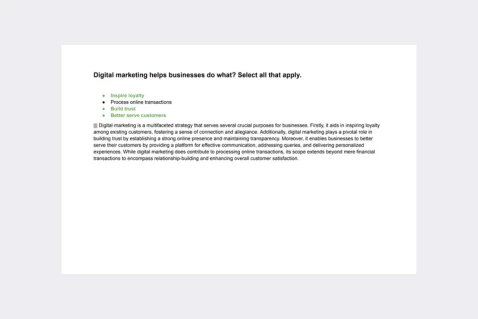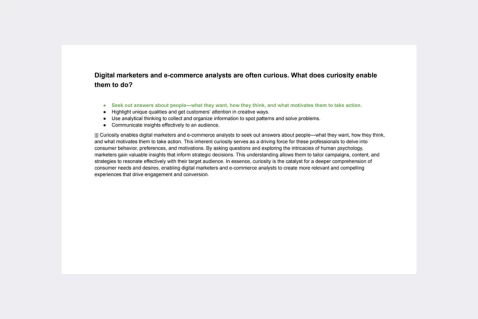A software company spends $100 on an ad. They make $150 as a result of that ad. The revenue they gained is 150%. What is this performance metric called?
Customer lifetime value
ROAS (return on ad spend)
Clicks
Targets
Certification program: 👉 Google Digital Marketing & E-commerce Professional Certificate (Coursera)
Explanation: The performance metric in this scenario is called ROAS (Return on Ad Spend). ROAS is calculated by dividing the revenue generated from an advertising campaign by the cost of that campaign and expressing it as a percentage. In this case, the software company spent $100 on the ad and made $150 in revenue, resulting in a ROAS of 150%. This metric indicates that for every dollar spent on the advertisement, the company gained $1.50 in revenue. Unlike metrics such as customer lifetime value, clicks, or targets, ROAS specifically focuses on the financial return derived from advertising expenditures, providing a clear measure of the campaign’s effectiveness in generating revenue.
Passing exams is not a workout. Multiple attempts won’t make you stronger.



- All possible certificate program questions
- Real certification exam questions
- Detailed answer explanations.
- Over 1700 questions, 7 courses, 30 quizzes
- Free lifetime updates.
Understanding Return on Investment (ROI) in Advertising: Maximizing Revenue and Performance
In the world of advertising and marketing, measuring the effectiveness of campaigns is crucial for determining their impact on business outcomes. One key performance metric that helps assess the success of advertising efforts is Return on Investment (ROI). But what exactly is ROI, and how does it provide valuable insights into the performance of advertising campaigns? Let’s delve into this topic and uncover some practical insights.
Understanding Return on Investment (ROI)
Return on Investment (ROI) is a performance metric used to evaluate the profitability of an investment relative to its cost. It measures the ratio of the net profit gained from an investment to the cost of the investment itself. In the context of advertising, ROI helps advertisers assess the financial returns generated from their ad spend. Here’s how ROI is calculated:
[ \text{ROI} = \left( \frac{\text{Revenue} - \text{Cost}}{\text{Cost}} \right) \times 100% ]
Practical Insights for Calculating ROI
-
Revenue Calculation: Revenue represents the total income generated from the advertising campaign. It includes sales, leads, or any other desired actions taken by customers as a result of the ad.
-
Cost Consideration: Cost refers to the total amount spent on the advertising campaign, including ad placement fees, creative production costs, and any other associated expenses.
-
Interpreting ROI: A positive ROI indicates that the advertising campaign generated more revenue than it cost to run, resulting in a profitable return on investment. Conversely, a negative ROI suggests that the campaign incurred losses.
Example Scenario: Calculating ROI for a Software Company
Suppose a software company invests $100 in an advertising campaign. As a result of the ad, they generate $150 in revenue. To calculate the ROI of this campaign:
[ \text{ROI} = \left( \frac{150 - 100}{100} \right) \times 100% = 50% ]
In this scenario, the software company achieved a 50% ROI, indicating that for every dollar invested in the advertising campaign, they earned an additional 50 cents in revenue.
Practical Implications of ROI Analysis
-
Optimizing Ad Spend: By analyzing ROI, advertisers can identify which advertising channels, campaigns, or strategies are delivering the highest return on investment. This enables them to allocate budget more effectively and optimize future campaigns for better results.
-
Setting Performance Benchmarks: ROI serves as a benchmark for assessing the effectiveness of advertising efforts over time. By tracking ROI metrics regularly, advertisers can monitor performance trends, identify areas for improvement, and set realistic goals for future campaigns.
-
Demonstrating Value: ROI provides tangible evidence of the value generated by advertising activities, helping marketers justify their ad spend to stakeholders and demonstrate the impact of their efforts on business growth and profitability.
Conclusion
Return on Investment (ROI) is a fundamental metric in advertising that helps advertisers evaluate the financial performance of their campaigns. By calculating ROI, advertisers can assess the profitability of their ad spend, optimize their strategies for maximum impact, and demonstrate the value of their efforts to stakeholders. Understanding and leveraging ROI enables advertisers to make informed decisions and drive meaningful results in their advertising endeavors.
Now, armed with a deeper understanding of ROI in advertising, how will you leverage this metric to maximize the effectiveness of your advertising campaigns and achieve your business objectives?
Discover our best-value guides
- Special Bundle Offer Google_Ads_Roll
- Special Bundle Offer HubSpot_Exams_Roll
- Special Offer Unchained_Guru_Roll
- Special Bundle Offer Amazon_Roll
- Special Bundle Offer Google_Analytics_Roll
- Special Bundle Offer Google_SkillShop_Roll
- Special Bundle Offer Marketing_Platforms_Roll
- Special Bundle Offer Microsoft_Advertising_Roll
- Special Bundle Offer YouTube_Roll
- Special Bundle Offer Google_Android_Roll
- Ultimate PMP certification preperation guide
- Google Cloud Professional Architect Certification Exam Answers - Ultimate Guide
- Special Bundle Offer SEMrush_Roll